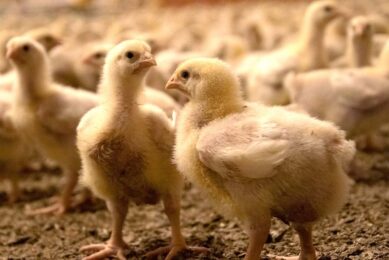Boosting poultry gut integrity with a source of charcoal

Pyrogenic carbonaceous materials (PCMs), otherwise known as charcoal, can bind harmful compounds and boost gut integrity.
Gut integrity is a hot topic in animal production. With intensifying production and a reduction in permitted pharmaceutical solutions to control infections, other strategies must be applied.
Purification and detoxification
Charcoal has been known and appreciated for thousands of years for its purifying effects. It was already used thousands of years ago by the Romans and Chinese to improve drinking water safety and for general detoxification purposes.
Water safety and quality
It is only in more recent times that the specific qualities and characteristics of charcoal have been studied in more detail. The purifying effects of charcoal are used today on an industrial scale worldwide to improve drinking water safety and quality. These properties have also attracted interest in its use for many other applications, ranging from skincare and teeth whitening, to improving gut integrity in both humans and animals.
Differences in quality
The wide range of solutions offered by charcoal is an indicator of its non-specific functionality. The differences in quality in the types of charcoal currently available explain both its widespread use and the varied levels of success with the use of charcoal in general.
Thermochemical conversion
Charcoal, biochar and activated carbon can all be grouped together under the heading of pyrogenic carbonaceous materials (PCMs), as they are produced by the thermochemical conversion of carbon-containing materials. The definitions of each are not specific, have changed over time and – with growing interest in their application – are increasingly starting to overlap, thus, possibly causing confusion.
The term ‘charcoal’ is non-specific enough for it to be used to cover the whole group of carbonaceous materials, replacing the correct umbrella term of PCMs.
Charcoal is often seen as a limited, processed and less standardised product based on vegetable materials. It can be used for barbecuing, for example. However, the term ‘charcoal’ is also non-specific enough for it to be used to cover the whole group of carbonaceous materials, replacing the correct umbrella term of PCMs. Biochar is a term originating from soil science based on the positive effect that charred biomass after forest fires has in significantly improving soil quality. An essential differentiator for biochar is that it must be produced from sustainably sourced biomass.
Activated carbon
The initial definition of activated carbon was “any form of carbon capable of adsorption” and so was very unspecific. The activation of charcoal was later further defined as “any process which selectively removes the hydrogen or hydrogen-rich fractions from a carbonaceous raw material in such a manner as to produce an open, porous residue”.
Determining the efficacy of mycotoxin mitigators
A challenge for the commercial marketing of feed additives to prevent mycotoxicosis has been proving product efficacy. Most methodology includes in vitro binding assays with individual purified mycotoxins, but extrapolating in vitro results to actual field conditions may not prove accurate. Read more…
The more recent definition includes not only opening existing pore structures by removing organic material but also breaking open the materials to create new pores, hence increasing the surface area. Activation can be done by increasing the temperature or amount of time, together with gases like oxygen or carbon dioxide, or by adding steam or chemicals during the process.
Functional properties
Like many products, the quality of the raw materials influences the quality of the final product and its properties. PCMs can be produced from many different sources, for example, bituminous coal, bones, coconut shells, lignite, peat, pecan shells, petroleum-based residues, pulp mill black ash, sugar, wastewater treatment sludge and wood.
The origin and process affect the final product
Of course, the specific origin of the PCM will significantly affect its final properties. The second important factor influencing the final product properties is the process applied. Firstly, the temperature used for the carbonisation process and secondly, the potential ‘activators’ involved. Both aspects can help to enhance the open pore structure, increasing pore size and volume and thus the total surface area of the product.
…impurities will naturally impact its quality and functional properties.
Application in animals
Various solutions are used today to prevent disease outbreaks or reduce their impact on animal welfare and performance. Besides improving health management, nutritional solutions may include improving protein digestibility and intestinal passage rate, prebiotics and probiotics, organic acids, as well as bio-active toxin and myco-toxin binders. All have different modes of action to support a balanced microbiome and healthy gut.
Toxin-binding properties
PCMs have toxin-binding properties but no direct effect (positive or negative) on either the microflora or gut integrity. The right source of PCM will bind enterotoxins produced by the microflora which would otherwise damage the gut. Such damage would lead to increased nutrient costs and enable pathogens to take hold due to inflammation and loss of gut integrity. By binding some of the toxins present, gut integrity can be better maintained.
In addition, PCMs can bind mycotoxins. Compared to the main toxin binders used globally, such as clays and yeast-based products, PCMs mainly bind non-polar or neutral compounds better. Something which is vital for essential mycotoxins, like deoxynivalenol and zearalenone.
Good charcoal source
As a result, the definitions and characteristics of PCMs and their functional properties can differ widely. At first sight, a more efficient PCM might seem to be the best option for inclusion in animal feeds. However, if used as a preventive and supportive solution over more extended periods, a highly efficient binder will not be ideal as it is not selective.
Factors affecting binding capacity
Hale and others found that the higher the process temperature and the greater the surface area of the PCM, the stronger its binding capacity for neutral organic compounds. That sounds good until you realise that this means that not only the harmful compounds (toxins) will be bound but also many nutrients provided by the feed, such as vitamins, minerals and medicines.
Binding larger molecules
Most important is to select a charcoal source with a pore structure that is open enough to bind toxins with medium to large molecules but which is not sufficient to bind the most essential nutrients made up of small molecules.
Binds toxins and not essential nutrients
A charcoal source selected specifically for inclusion in animal feed is commercially available from Pancosma, under the name of Carbovet. As a natural solution – and available in Europe as an organically-certified feed material – this vegetable charcoal is well-suited to provide support for gut integrity. Based on oak wood of a single quality and origin and a controlled thermal process, the final product quality is highly standardised.
A process using a medium temperature (550-600°C) for several days, without further activation with gas, steam or chemicals and of high purity, ensures efficient toxin binding without binding essential nutrients. All in all, a very effective solution for in-feed application.
This article applies to non-NA regions.
Author:
Mieke Zoon, Pancosma
Join 31,000+ subscribers
Subscribe to our newsletter to stay updated about all the need-to-know content in the poultry sector, three times a week. Beheer
Beheer








 WP Admin
WP Admin  Bewerk bericht
Bewerk bericht